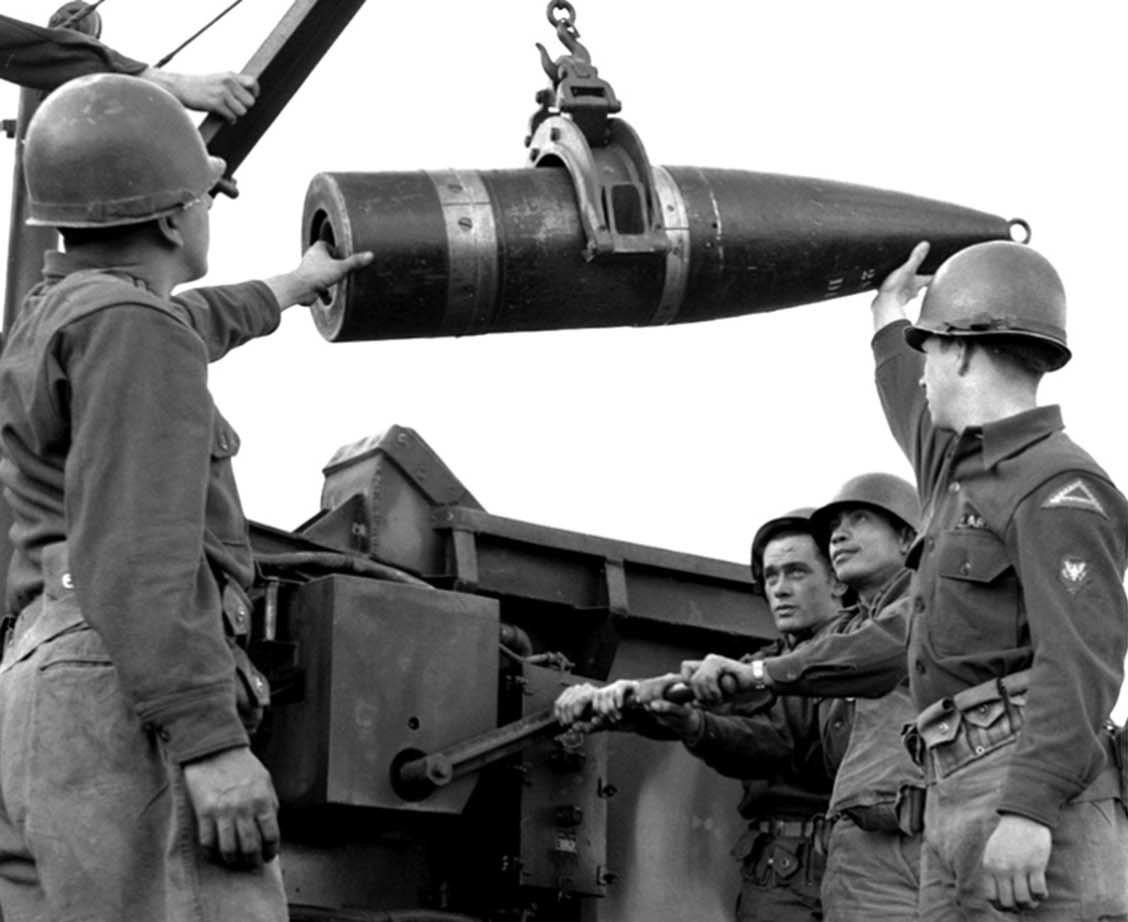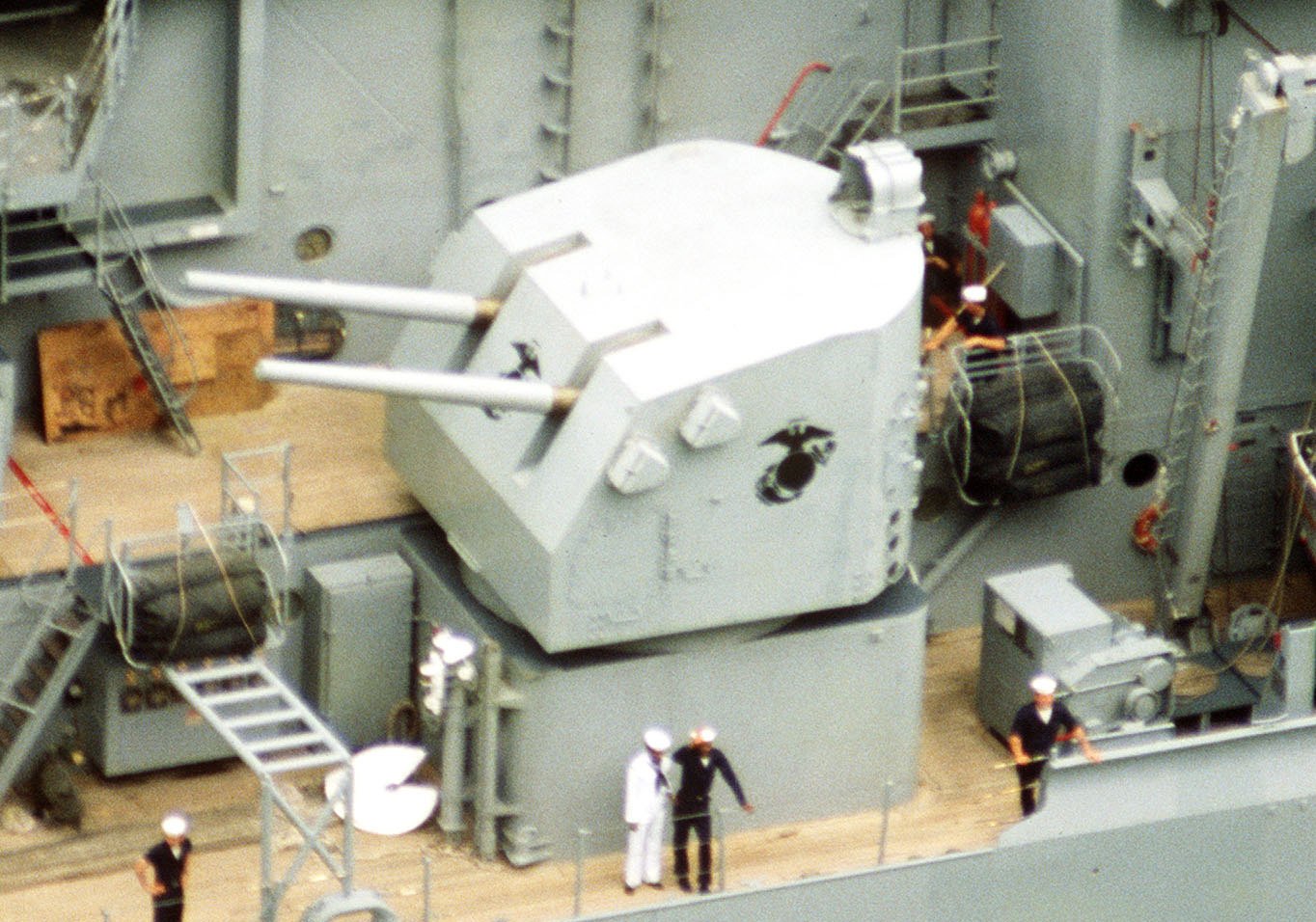|
W23 (nuclear Artillery Shell)
The W19, also called Katie, was an American nuclear artillery shell, derived from the earlier W9 shell. The W19 was fired from a special howitzer. It was introduced in 1955 and retired in 1963. Specifications The W19 was in diameter, long, and weighed . It had a yield of 15-20 kilotons and was like its predecessor the W9, a gun-type nuclear weapon. Variants W23 The W19 nuclear system was adapted into a nuclear artillery shell for the US Navy's 16-inch (406 mm) main battery found on the ''Iowa''-class battleships, the W23. Production of the W23 began in 1956 and they were in service until 1962, with a total of 50 units being produced. The W23 was 16 inches (406 mm) in diameter and long, with a weight given variously as in reference sources. As with the W19, yield was 15-20 kilotons. See also * Nuclear artillery * List of nuclear weapons This is a list of nuclear weapons listed according to country of origin, and then by type within the states. United States US nucle ... [...More Info...] [...Related Items...] OR: [Wikipedia] [Google] [Baidu] |
Nuclear Artillery
Nuclear artillery is a subset of limited- yield tactical nuclear weapons, in particular those weapons that are launched from the ground at battlefield targets. Nuclear artillery is commonly associated with shells delivered by a cannon, but in a technical sense short-range artillery rockets or tactical ballistic missiles are also included. The development of nuclear artillery was part of a broad push by nuclear weapons countries to develop nuclear weapons which could be used tactically against enemy armies in the field (as opposed to strategic uses against cities, military bases, and heavy industry). Nuclear artillery was both developed and deployed by a small group of states, including the United States, the Soviet Union, and France. The United Kingdom planned and partially developed such weapon systems (the Blue Water missile and the Yellow Anvil artillery shell) but did not put them into production. A second group of states has derivative association with nuclear artille ... [...More Info...] [...Related Items...] OR: [Wikipedia] [Google] [Baidu] |
W9 (nuclear Warhead)
The W9 was an American nuclear artillery shell fired from a special howitzer. It was produced starting in 1952 and all were retired by 1957, being superseded by the W19. Description The W9 was in diameter, long, and weighed . It had an explosive yield of . The W9 was a gun-type nuclear weapon, using around of highly enriched uranium in one large rings assembly and one smaller ''bullet'', which was fired down a tube by conventional explosives into the rings assembly to achieve critical mass and detonate the weapon. The W9 units which were retired in 1957 were recycled into lower yield T-4 Atomic Demolition Munitions. These were the first (semi) man-portable nuclear weapons. Tests The W9 is only the second gun-type nuclear weapon known to have been detonated; the first was the Little Boy nuclear weapon used in World War II. The W9 artillery shell was test fired once, fired from the "Atomic Annie" M65 Atomic Cannon, in ''Upshot-Knothole Grable'' on May 25, 1953 at the ... [...More Info...] [...Related Items...] OR: [Wikipedia] [Google] [Baidu] |
Kiloton
TNT equivalent is a convention for expressing energy, typically used to describe the energy released in an explosion. The is a unit of energy defined by that convention to be , which is the approximate energy released in the detonation of a tonne, metric ton (1,000 kilograms) of Trinitrotoluene, TNT. In other words, for each gram of TNT exploded, (or 4184 joules) of energy is released. This convention intends to compare the destructiveness of an event with that of conventional explosive materials, of which TNT is a typical example, although other conventional explosives such as dynamite contain more energy. Kiloton and megaton The "kiloton (of TNT)" is a unit of energy equal to 4.184 tera-, terajoules (). The "megaton (of TNT)" is a unit of energy equal to 4.184 peta-, petajoules (). The kiloton and megaton of TNT have traditionally been used to describe the energy output, and hence the destructive power, of a nuclear weapon. The TNT equivalent appears in various CTBT, n ... [...More Info...] [...Related Items...] OR: [Wikipedia] [Google] [Baidu] |
Nuclear Weapon Design
Nuclear weapon designs are physical, chemical, and engineering arrangements that cause the physics package of a nuclear weapon to detonate. There are three existing basic design types: * pure fission weapons, the simplest and least technically demanding, were the first nuclear weapons built and have so far been the only type ever used in warfare (by the United States on Empire of Japan, Japan during World War II, WWII). * boosted fission weapons increase yield beyond that of the implosion design by using small quantities of fusion fuel to enhance the fission chain reaction. Boosting can more than double the weapon's fission energy yield. * thermonuclear weapon, staged thermonuclear weapons are essentially arrangements of two or more "stages", most usually two. The first stage is normally a boosted fission weapon as above (except for the earliest thermonuclear weapons, which used a pure fission weapon instead). Its detonation causes it to shine intensely with x-radiation, which ... [...More Info...] [...Related Items...] OR: [Wikipedia] [Google] [Baidu] |
16-inch/50-caliber Mark 7 Gun
The 16"/50 caliber Mark 7 – United States Naval Gun is the main armament of the ''Iowa''-class battleships and was the planned main armament of the cancelled . Description Due to a lack of communication during design, the Bureau of Ordnance assumed the ''Iowa'' class would use the /50 Mark 2 guns constructed for the 1920 ''South Dakota''-class battleships. However, the Bureau of Construction and Repair assumed that the ships would carry a compact 16-in/50 turret and designed the ships with barbettes too small to accommodate the 16-in/50 Mark 2 three-gun turret that the Bureau of Ordnance was actually working on. The new lightweight 16-in/50 Mark 7 was designed to resolve this conflict. These guns were 50 calibers long—or 50 times their bore diameter, which makes the barrels long, from chamber to muzzle. Each gun weighed about without the breech, and with the breech. They fired projectiles weighing from at different muzzle velocities, depending on the shell. Whe ... [...More Info...] [...Related Items...] OR: [Wikipedia] [Google] [Baidu] |
Iowa-class Battleship
The ''Iowa'' class was a class of six fast battleships ordered by the United States Navy in 1939 and 1940. They were initially intended to intercept fast capital ships such as the Japanese while also being capable of serving in a traditional battle line alongside slower battleships and act as its "fast wing". The ''Iowa'' class was designed to meet the Second London Naval Treaty's "escalator clause" limit of standard displacement. Four vessels, , , , and , were completed; two more, and , were laid down but canceled in 1945 and 1958, respectively, before completion, and both hulls were scrapped in 1958–1959. The four ''Iowa''-class ships were the last battleships commissioned in the US Navy. All older US battleships were decommissioned by 1947 and stricken from the ''Naval Vessel Register'' (NVR) by 1963. Between the mid-1940s and the early 1990s, the ''Iowa''-class battleships fought in four major US wars. In the Pacific Theater of World War II, they served primarily as fas ... [...More Info...] [...Related Items...] OR: [Wikipedia] [Google] [Baidu] |
Nuclear Artillery
Nuclear artillery is a subset of limited- yield tactical nuclear weapons, in particular those weapons that are launched from the ground at battlefield targets. Nuclear artillery is commonly associated with shells delivered by a cannon, but in a technical sense short-range artillery rockets or tactical ballistic missiles are also included. The development of nuclear artillery was part of a broad push by nuclear weapons countries to develop nuclear weapons which could be used tactically against enemy armies in the field (as opposed to strategic uses against cities, military bases, and heavy industry). Nuclear artillery was both developed and deployed by a small group of states, including the United States, the Soviet Union, and France. The United Kingdom planned and partially developed such weapon systems (the Blue Water missile and the Yellow Anvil artillery shell) but did not put them into production. A second group of states has derivative association with nuclear artille ... [...More Info...] [...Related Items...] OR: [Wikipedia] [Google] [Baidu] |
List Of Nuclear Weapons
This is a list of nuclear weapons listed according to country of origin, and then by type within the states. United States US nuclear weapons of all types – bombs, warheads, shells, and others – are numbered in the same sequence starting with the Mark 1 and () ending with the W-91 (which was canceled prior to introduction into service). All designs which were formally intended to be weapons at some point received a number designation. Pure test units which were experiments (and not intended to be weapons) are not numbered in this sequence. Early weapons were very large and could only be used as free fall bombs. These were known by "Mark" designators, like the Mark 4 which was a development of the Fat Man weapon. As weapons became more sophisticated they also became much smaller and lighter, allowing them to be used in many roles. At this time the weapons began to receive designations based on their role; bombs were given the prefix "B", while the same warhead used in other r ... [...More Info...] [...Related Items...] OR: [Wikipedia] [Google] [Baidu] |
Nuclear Warheads Of The United States
*
*
{{Disamb ...
Nuclear may refer to: Physics Relating to the nucleus of the atom: *Nuclear engineering *Nuclear physics *Nuclear power *Nuclear reactor *Nuclear weapon *Nuclear medicine *Radiation therapy *Nuclear warfare Mathematics *Nuclear space *Nuclear operator *Nuclear congruence *Nuclear C*-algebra Biology Relating to the nucleus of the cell: * Nuclear DNA Society *Nuclear family, a family consisting of a pair of adults and their children Music * "Nuclear" (band), group music. * "Nuclear" (Ryan Adams song), 2002 *"Nuclear", a song by Mike Oldfield from his ''Man on the Rocks'' album * ''Nu.Clear'' (EP) by South Korean girl group CLC See also *Nucleus (other) *Nucleolus *Nucleation *Nucleic acid *Nucular ''Nucular'' is a common, proscribed pronunciation of the word "nuclear". It is a rough phonetic spelling of . The ''Oxford English Dictionary''s entry dates the word's first published appearance to 1943. Dictionary notes This is one of two con ... [...More Info...] [...Related Items...] OR: [Wikipedia] [Google] [Baidu] |



.jpg)


